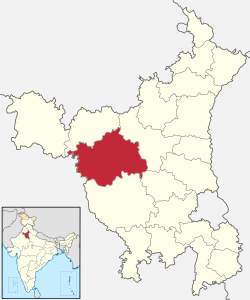Hansi
| Hansi हांसी | |
|---|---|
| city | |
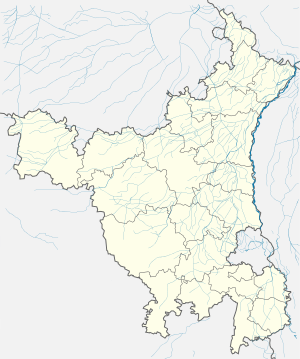 Hansi  Hansi | |
| Coordinates: 29°06′N 75°58′E / 29.1°N 75.97°ECoordinates: 29°06′N 75°58′E / 29.1°N 75.97°E | |
| Country |
|
| State | Haryana |
| District | Hisar |
| Elevation | 207 m (679 ft) |
| Population (2001) | |
| • Total | 75,730 |
| Languages | |
| • Official | Haryanvi, Hindi |
| Time zone | UTC+5:30 (IST) |
| PIN | 125033 |
| Telephone code | 01663 |
| ISO 3166 code | IN-HR |
| Vehicle registration | HR 21 |
| Website |
haryana |
Hansi (Hindi: हांसी), (Urdu: ہانسی ), is a city, a municipal council and Hansi (Vidhan Sabha constituency) in Hisar district in the Indian state of Haryana. It is located at a distance of 26 kilometres (16 mi) east of Hisar on NH-9. Geographically, it is semi-arid with around 46 cm of annual rainfall. It appears that at one time Hansi was larger, more prosperous and more important than Hisar. The town has several important buildings of archeological importance.
In 2016, the Haryana government put forward a proposal to carve the new Hansi district out of the Hisar district.[1]
The City
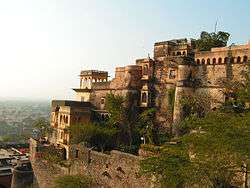
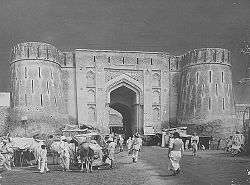
Barsi gate
The city of Hansi has five gates of entry – Delhi Gate (East), Hisar Gate (West), Gosain Gate (North-west), Barsi Gate(South) and Umra Gate (South west). The peculiarity of this town is that its altitude increases after entry from any of the gates. Deserts guard this city towards its west (cities like Tosham, Devsar, Khanak).
Another prominent feature of this ancient city is its fort. Extended in an area of 30 acres (120,000 m2), it is square in shape and has security posts in all the four corners. The fort is said to be that of Great King Prithvi Raj Chauhan.
Later, the son of King Anangpal, Drupad established a sword manufacturing factory in this fort, hence it is also called "Asigarh". Swords from this fort were exported as far away as to Arab countries. As per Talif-e-Tajkara-e-Hansi by Qazi Sharif Husain in 1915, around 80 forts across the area were controlled from this centre "Asigarh".
During the period of Firoz Shan Tuglaq, an underground tunnel was constructed connecting the present Hansi to Hisar. The gate of fort has figures of gods, and pictures of gods, goddesses, birds can also be seen on the walls of the fort. The entry gate of the fort was built by George Thomas. This fort was declared a Protected Monument of National Importance in 1937 by the Archeological Survey, the present ASI, and is still in good condition, a must visit site for all archeologists.
Jain and Buddhist heritage
Right in front of the Fort, ancient statues of "Jain God" Mahavira and "Founder of Buddhism" Gautama Buddha are placed. These statues are worth $1 million as calculated by the Archeologists.
Sikh and Maratha rule
The Sikhs captured Hansi area in 1778, and established a Sikh Empire rule under Jind State for some time in this Area until Hansi fell to the Maratha Empire.
British colonial rule
Area came under British rule after 1803 till 1947. After the Indian Rebellion of 1857, British empire crushed over 100 people from Rohnat, Mangali, Hazampur, Jamalpur, Bhatla and other villages under a road roller on the road as punishment for participating in the mutiny. That road is now known as Lal Sadak (literally Red Road or Blood Road) where a monument, on approach road from Hansi to Rohnat Lal Sadak, to the martyrs has been constructed after the independence.[2]
History
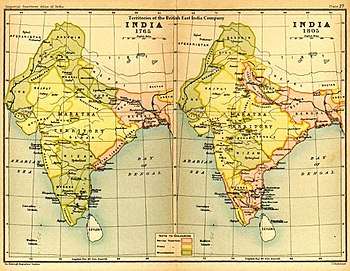
_%2C_19th_century.jpg)
Though the origin of this city is wrapped in controversies, some prominent names and documentary proof like "Majkura Hansi" describe it as being founded by ill daughter Hansivati/Ambavati of Prithvi Raj Chauhan. Others say it was founded two centuries earlier by King Anangpal Vihangpal Tomar for his guru "Hansakar" (957 AD).
A large hoard of Jaina bronzes was accidentally discovered at Hansi in February 1982. These include idols that may belong to the Gupta period (319 to 605 CE), while most belonged to the 7th–8th centuries. They were apparently buried underground before the impending attack by Mahmud of Ghazni's son Mas'ud I of Ghazni in 1037 CE. Masud attacked swordsmen of Hansi and took women into slavery who were later sold at Gazni.[3]
In 1192, after the defeat of Prithvi Raj Chauhan by Mohammed Gauri, Hindu rule ended in Hansi. This was the time when non-Muslims were not permitted to settle here. Slowly, Hansi lost its importance and was remembered only as a fort. Delhi started becoming the center of attention.
Shahjahan came to Hansi, met the famous Hindu saint Jagannath Puri Samadha Hansi and after his approval Hindus were allowed to settle in Hansi. In addition to the Hindus, Hansi had Muslims and a few Jains that inhabited Hansi during this Mughal rule.
Guru Gobind Singh also came to Hansi in 1705 and inspired Hindus to revolt against the oppressive Mughal rule. In 1707, Lakshman Singh (Banda Singh Bahadur) attacked Hansi. Hansi was under Maratha rule in 1736 and, after Third Battle of Panipat in 1761, was lost to Ahmed Shah Abdali. Maharaja Jassa Singh Ramgarhia in 1780s also took this area under his control for some years and then left
George Thomas, an Irish adventurer who rose from an ordinary sailor to become an independent king, formed Hansi as his capital. Hansi came under British East India Company rule in 1802. From 1819–32, Hansi was a District HQ which was later shifted to Hisar in 1832.
Hansi was also the headquarters of Colonel James Skinner CB (1778 – 4 December 1841) the Anglo-Indian military adventurer in India, who became known as Sikandar Sahib. 1st Skinner's Horse and 3rd Skinner's Horse (formerly 2nd Skinner's Horse) were founded by Colonel James Skinner at Hansi in 1803. These units are still part of the Indian Army.[4] He also built the Sheikhpura Kothi, on Hansi-Ugalan road off NH9 Hansi bypass, named after his son.
Raham Ali ibn Mohammad Hussain ibn Maulana Abul Khair of Palwal was killed along with Aulia Khan Balooch at Pargana Hansi.[5] Raham Ali was brother-in-law of Qazi Syed Mohammad Rafi.
After the Anglo-Maratha Wars Hansi came under British rule. Hansi took active part in the 1857 war of liberation (Gadar), Lala Hukam Chand Jain was martyred in 1857 by Britishers.
In 1947 when British India was divided into Pakistan and India, a large number of Muslims including Syeds and Ranghars migrated to Pakistan from Hansi city and their villages (such as Baliali and Khanak). Pakistani cricket player Inzamam-ul-Haq's parents migrated to Pakistan from Hansi after partition.[6]
Dr. Bhup Singh, historian, has written Hansi ka Etias, a History of Hansi, a book published by Rotary International. He has also written two other books and has been linked to a number of local social organisations.
Hansi is known for its famous sweet peda which is made from milk and is sent to many other towns and cities for retail selling.
Geography
Hansi is located at 29°06′N 75°58′E / 29.1°N 75.97°E.[7] It has an average elevation of 207 metres (679 ft).
Demographics
As per census of India data, Hansi had a population of 75,730 in 2001,[8] which rose to 86,770 by 2011.[9] In 2011, female sex ratio was 883 per 1000 men and female child sex ratio was 830.[9] In 2011, Hansi had an average literacy rate of 81.06% (68% in 2001), higher than the state average of 75.5%, male literacy is 86.59% (73% in 2001), and female literacy is 74.84% (61% in 2001).[9] In Hansi, 11.41% of the population is under 6 years of age.[9]
Religion
In 2011, 96.77% of residents are Hindus, 1.34% Jain, 0.99% Sikhs, 0.05% Buddhist, 0.66% Muslim, 0.10% Christian and 0.10% unstated.[9]
Education
- Colleges
- Nehru Memorial Government College, Hansi
- Universal Institute of Technology, Hansi is an engineering college
- Schools
Hansi has several schools. There are 4 major schools Baba Banda Bahadur Public School, Shree Kali Devi Vidya Mandir, S D Modern Public School, and Shree Krishna Pranami Public School [10]. There is also DPS Hisar (a branch of Delhi Public School) which lies outside the city but provides transportation options to the city.
See also
References
- ↑ Haryana mulls creation of three new districts: Charkhi, Hansi and Gohana
- ↑ "Hisar admn never unfurled Tricolour at ‘Lal Sadak’.", The Tribune, 14 August 2015.
- ↑ Jaina Bronzes From Hansi, by Devendra Handa, Indian Institute of Advanced Study, 2002
- ↑ Colonel James Skinner CB Archived 18 December 2010 at the Wayback Machine. National Army Museum (British Army).
- ↑ Hakim Syed Zillur Rahman (2008). "Chapter: Qazi Mohammad Rafi". Ḥayāt-i Karam Ḥusain (in Urdu) (2nd ed.). Aligarh, India: Ibn Sina Academy of Medieval Medicine and Sciences. pp. 48–54. OCLC 852404214. 978-89060706 (invalid ISBN).
- ↑
- ↑ Falling Rain Genomics, Inc – Hansi
- ↑ "Census of India 2001: Data from the 2001 Census, including cities, villages and towns (Provisional)". Census Commission of India. Archived from the original on 2004-06-16. Retrieved 2008-11-01.
- 1 2 3 4 5 2011, Hansi Population Census 2011, Census of India.
- ↑ https://www.google.co.in/search?q=schools+in+hansi
- "Hansi Town". The Imperial Gazetteer of India, Vol. 13. Oxford at Clarendon Press. 1909. p. 25.
- "Excavation at Hansi fort begins". The Tribune. India. 4 December 2004.
